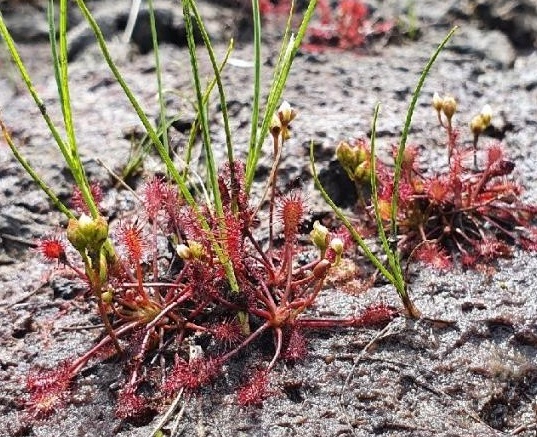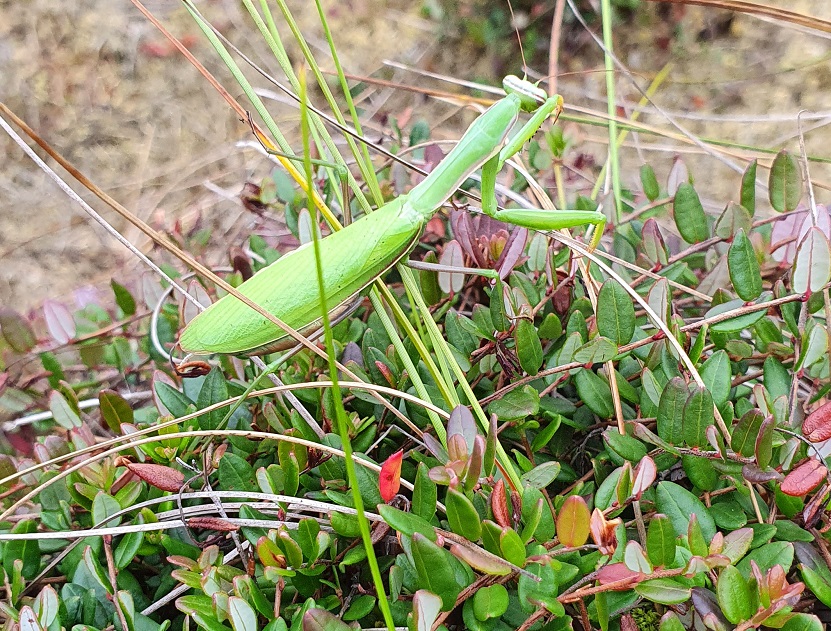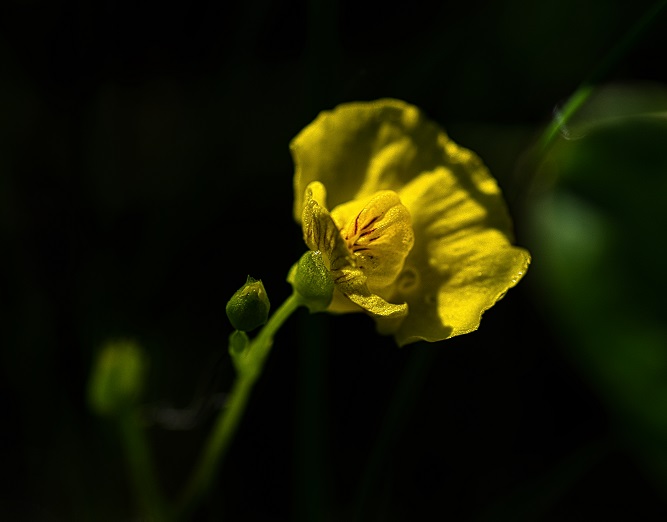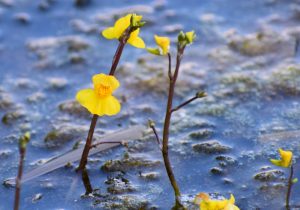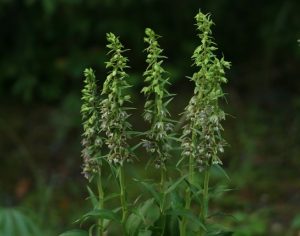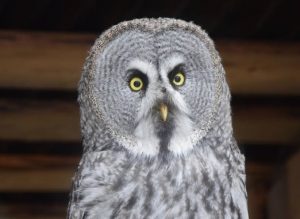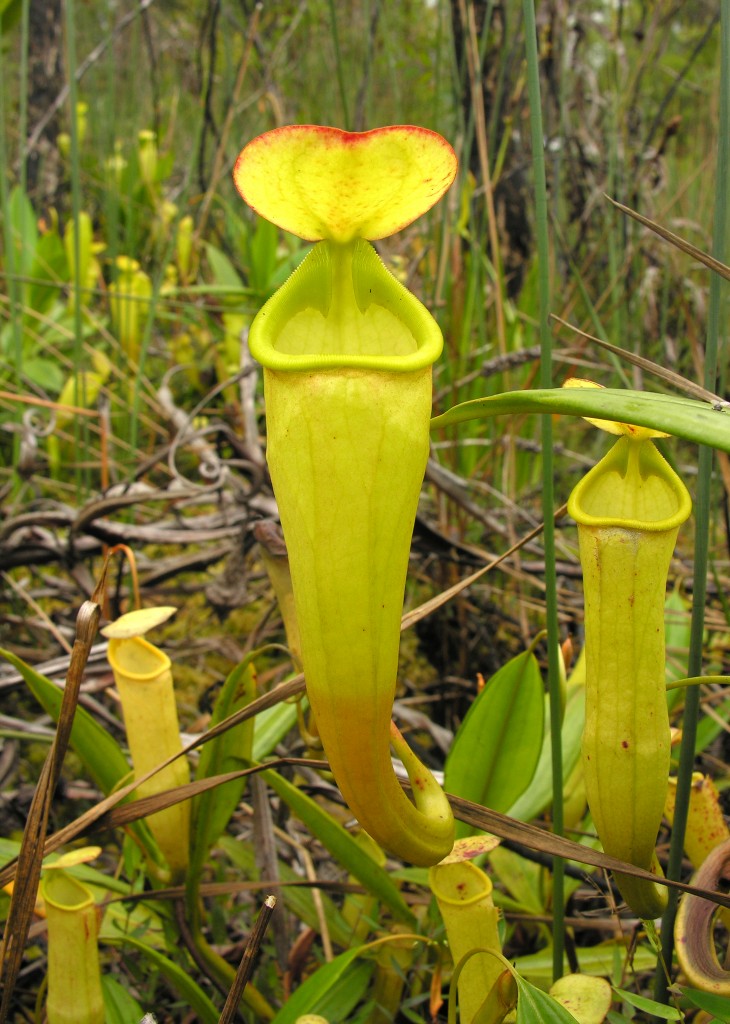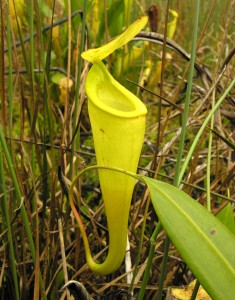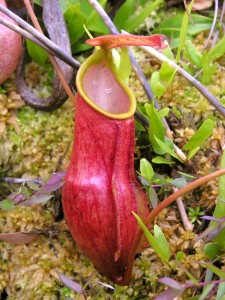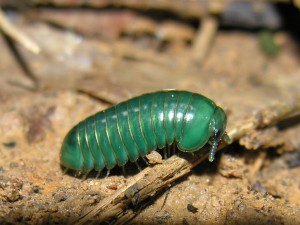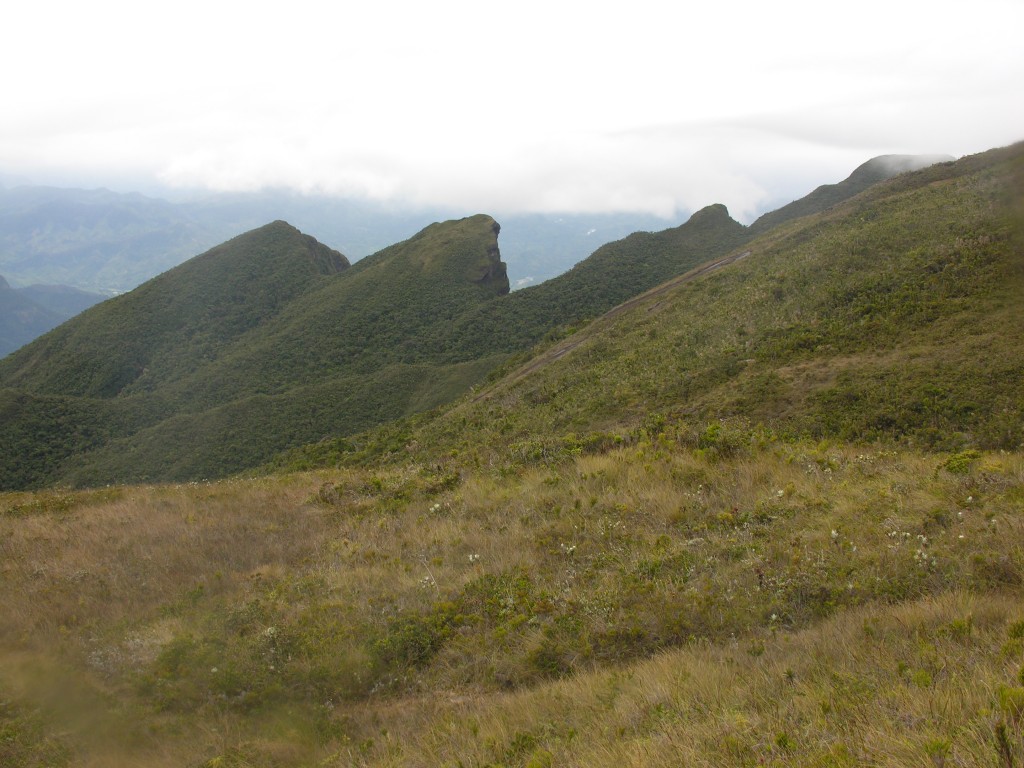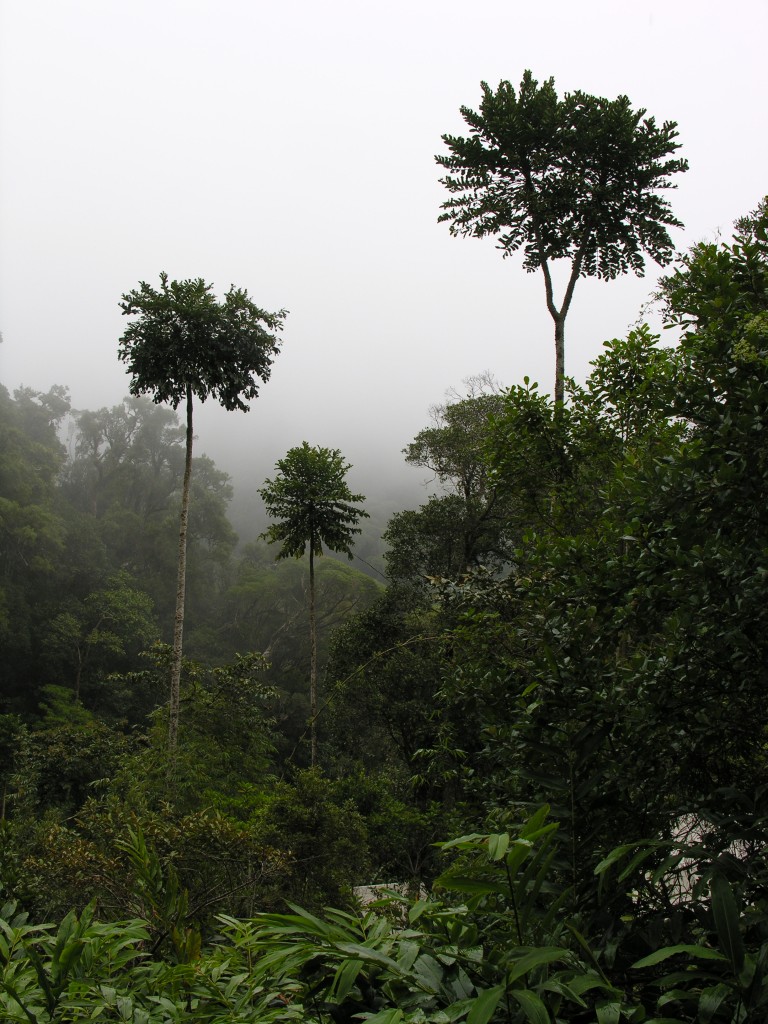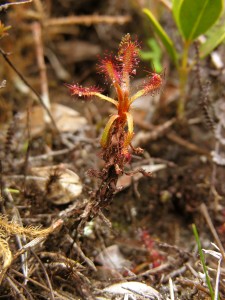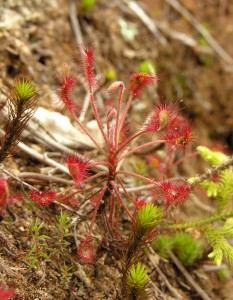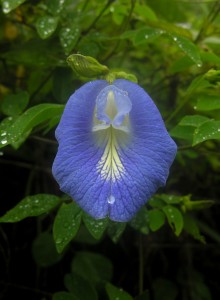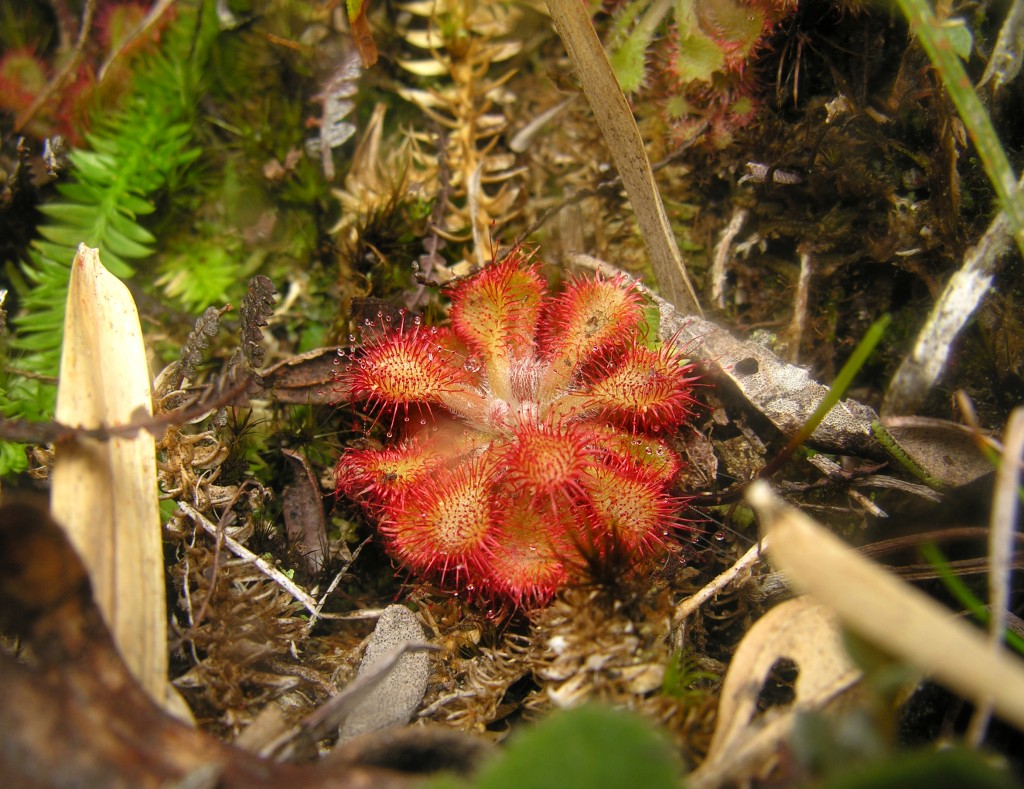In 2007 I traveled to Madagascar to study and photograph the carnivorous plants of that island. The first species which I intended to find was Nepenthes madagascariensis – a spectacular pitcher plant that is found only on the island of Madagascar. Nepenthes madagascariensis is in many respects, a very special species of pitcher plant, it was the first of its genus to be discovered, the earliest known record of it being a description published by Etienne de Flacourt recorded in 1658. The description of the plant reads:
It is a plant growing about 3 feet high which carries at the end of its leaves, which are 7 inches long, a hollow flower or fruit resembling a small vase, with its own lid, a wonderful sight. There are red ones and yellow ones, the yellow being the biggest. The inhabitants of this country are reluctant to pick the flowers, saying that if somebody does pick them in passing, it will not fail to rain that day. As to that, I and all the other Frenchmen did pick them, but it did not rain. After rain these flowers are full of water, each one containing a good half-glass.
We now know that the ‘hollow flower or fruit resembling a small vase’ which Etienne de Flacourt astutely described are the plants ‘pitchers’ – specialized leaves that are adapted to attracting, trapping and digesting insect prey which allows this carnivorous plant to augment nutrients and survive in hostile, barren habitats that are deficient in minerals and nutrients. Arthropod prey is attracted to the plants traps by secretions of nectar and the bright colouration of the pitchers, and eventually falls within the pitchers to drown and be digested in the liquid contained within.
I traveled to the South of Madagascar to the town of Fort Dauphin where I met a local botanist friend who had kindly agreed to take me to see Nepenthes madagascariensis in its natural habitat nearby. The plant is extremely common across the south of Madagascar although it is also found across the wetter western half of Madagascar and the north west coast of the island. I observed it growing in a sphagnum bog, a few kilometers from the town of Fort Dauphin in a location where hundreds of plants were thriving among bananas and palms rooted in pure sphagnum moss in standing water.
Nepenthes madagascariensis produces spectacular leaves up to 40 cm in length, from which the pitchers emanate on long, thin tendrils. Each pitcher is up to 25 cm in total length and in shape they are more or less funnel shaped. One of the distinctive characteristics of this spectacular species is that the peristome (the rim of the opening of the pitcher) forms two distinctive spikes at the top of the pitcher opening, and this trait was present in all of the plants which I saw. Almost all species of Nepenthes produce two types of pitcher – the so called ‘lower pitchers’ rest on the ground, whereas the ‘upper pitchers’ are produced as the plant climbs and forms a vine. The ‘upper pitchers’ of Nepenthes madagascariensis are spectacular and usually are pure bright yellow in colour. The lower traps are consistently reddish purple and usually more bulbous in shape.
The two pitcher types explains Etienne de Flacourt’s description of the red and yellow vase-like structures that he noticed, and quite correctly, the yellow upper pitchers are consistently larger than the red lower traps – precisely as he observed.
There is one more species of Nepenthes on the island of Madagascar – a species called Nepenthes masoalensis which originates exclusively from the Masoala Peninsula on the west coast of Madagascar and also the Mount Ambato region. Nepenthes masoalensis is closely related to Nepenthes madagascariensis however extremely rare in the wild. The Masoala Peninsula is extremely remote and inaccessible and special permits are required in order to travel there. Unfortunately, during my visit to Madagascar, it was not possible for me to travel to the Masoala Peninsula to search for Nepenthes masoalensis so for the remained part of my trip, I focused on studying the spectacular carnivorous sundews of Madagascar.
The sundews (Drosera) are among the most successful of all genera of carnivorous plants. They catch insects by producing brightly coloured leaves that are lined with mobile tentacles tipped with droplets of sticky water based glue. The glue sparkles and shines in sunlight and attracts insects that are drawn to the shimmering effect of refracted light. On contact insects become immediately stuck to the leaves and entangled amidst the glue laden tentacles, and as the insect struggles to get free, its movement stimulates the leaf to slowly curl and envelop the prey until it eventually suffocates or dies of exhaustion. The small body of the victim remains stuck to the plant’s leaves and over the course of a few days, enzymes are secreted from specialized glands on the surface of the plant’s leaves which break down the remains of the prey and release nutrients which the sundew absorbs directly. Eventually rain washes away the remains of the digested prey and new glue is secreted, so the trap is ready for a new victim. Most of the Madagascan species of sundews trap mainly flying insects, ants, and beetles.
There are many species of sundews on Madagascar, however one in particular is particularly interesting and altogether unique. In 1955, the French naturalist Henri Humbert ascended a remote mountain called Mount Marojejy and studied its plant life of that mountain for the first time. On the summit of Mount Marojejy he discovered a strange species of sundew, which unlike all other African species, forms a truly self supporting stem, rigid stem. The following year the plant was named in his honour – Drosera humbertii – and it has only ever been studied on a few occasions since. It has never been found anywhere else, except the summit of Mount Marojejy in the north east of Madagascar, so traveled north to try and climb this remote peak to study the little known plant.
Mount Marojejy lies within the Marojejy National Park, and before climbing the mountain, I acquired permits and hired two guides to make the ascent legally and safely. The trek began by approaching the mountain for several kilometers through the dense, lush and very beautiful rainforest which covers the foothills of Mount Marojejy. For several hours, we trekked through the dense forest towards the mountain – the protected forests literally teemed with wildlife, including lemurs, a plethora of birds and some very interesting arthropods. I observed an large species of black millipede 10 cm long which when disturbed, rolled up into a perfect ball about the size of a gold ball. Soon afterwards, I encountered a species of bright green, iridescent pill millipede which was conspicuous amongst the brown leaf litter. After trekking for ten hours, we camped at a wooden shelter which the national parks authorities had built below the summit of the great mountain, surrounded by the calls and sounds of spectacular tropical birds and lemurs. The following morning, we began our final ascent to the summit of the mountain and after four hours of climbing through heavy rainfall and mist, we arrived at the barren, windswept summit which was devoid of trees and covered only in low growing grasses, orchids and small shrubs.
Henri Humbert had recorded Drosera humbertii as growing only on the summit of Mount Marojejy so on arriving on the peak of the mountain, I began to search extensively for the small plant I had come to study. It rains almost every day on the summit of Mount Marojejy and my guides had warned me that we could only stay an hour or so before we had to descend, because rain and storm clouds were soon to return. Eventually, I found the spectacular plant growing amongst the heath-like vegetation. True to Henri Humbert’s description, established specimens form spectacular woody stems up to 15 cm long, so that the plants’ sticky foliage is elevated above the surrounding vegetation and into brighter conditions and a more conspicuous position for trapping prey. Each plant, growing atop of its woody stem, consisted of several bright red sticky leaves up to three centimeters in length, quite unlike all other African sundews. It had been previously noted that Drosera humbertii plants probably grow extremely slowly in the wild, and indeed it was easily conceivable that each plant could likely be many years (possibly decades) old.
As my guides had predicted, soon the storms began to roll in and I was forced to descend the mountain and return to the safety of the shelters below. We later continued to descend the mountain and we retraced our footsteps along the trail we had previously climbed. As we descended the mountain I noticed two further species of carnivorous sundews. The first was Drosera madagascariensis – a large, stem forming species which produces sticky leaves that are bright red in colour. This species differs from Drosera humbertii in that it occurs at much lower altitudes and produces leaves that are different in their overall shape and structure. Despite its name, Drosera madagascariensis is found across much of southern Africa, although it was first discovered on the island of Madagascar.
A little further on I found a third species of sundew – a compact species called Drosera natalensis which forms small, dense rosettes of bright red, sticky leaves. This plant also occurs across Southern Africa however the population on Mount Marojejy is more compact and beautiful than anywhere else in the range of this species.
We descended into the rainforest below the summit of Mount Marojejy and once again heard the calls of the lemurs in the trees above us. Since it was almost nightfall, we camped once more in a wooden shelter which had been set up to accommodate tourists and on the following day, finally returned back along the path to a nearby village. Close to rice fields, I observed the spectacular, electric blue flower of Clitoria ternatea – a legume which is increasingly cultivated by horticulturalists for the spectacular electric blue colouration of its blooms.
After leaving Mount Marojejy I returned to Antananarivo the capital of Madagascar to return home. Madagascar is a land of incredible biological diversity and one in which the importance of the native flora and fauna is increasingly appreciated and protected. Since Mount Marojejy and much of the habitat surrounding Fort Dauphin remains completely protected from logging and degradation by agriculture, the future survival of the four spectacular Madagascan carnivorous plants which I studied looks positive. Hopefully these remarkable plants will remain as a permanent part of Madagascar’s remarkable natural heritage.
Stewart McPherson
